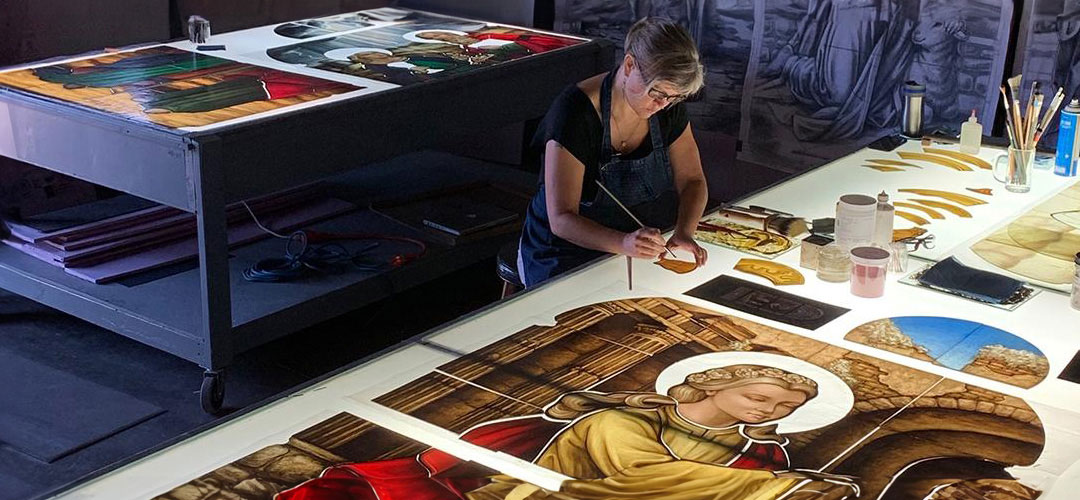
Stained glass windows are more than decorative features in churches – they are visual storytellers, steeped in history, artistry, and faith.
However, the intricate beauty of these windows is also fragile. Age, weather, and environmental changes can diminish or damage their brilliance over time, leaving churches with the challenge of preservation and restoration. Enter the need for a stained glass factory that specializes in church restoration.
For more than 125 years, Willet Stained Glass Studios has been a leader in the creation, restoration, and preservation of stained glass windows. With craftsmanship backed by more than a century of experience and a reputation for excellence, Willet has been the trusted partner for more than 36,000 buildings.
This guide takes you behind the scenes at Willet Stained Glass Studios’ factory and serves as a resource for church leaders, architects, and historians looking to preserve these vibrant masterpieces.
The History and Significance of Stained Glass
Stained glass has adorned places of worship for centuries, creating a celestial connection between light and color that tells biblical stories and inspires devotion. From Gothic cathedrals in Europe to American churches, stained glass factories have produced windows that have evolved in style while maintaining their sacred purpose.
Common stained glass types in churches include intricate, hand-painted pictorial panels, vibrant geometric designs, and colorful mosaics that combine symbolism and artistry. However, preserving these windows poses unique challenges. Time, weather conditions, UV light, and environmental pollutants can degrade the glass, lead, and delicate paintwork.
Beyond their aesthetic and spiritual significance, stained glass windows have also served as educational tools throughout history. During times when literacy rates were low, these vivid, intricate depictions of biblical scenes and saints functioned as visual scriptures, enabling congregations to connect with religious teachings without the need for written texts. This combination of artistry and storytelling highlights the enduring cultural and historical importance of stained glass within sacred spaces.
To ensure the longevity of these treasured windows, understanding when to turn to a stained glass factory to restore them is essential.
Recognizing When Restoration is Needed
Neglecting stained glass routine maintenance can lead to irreversible damage and loss of historical value. Here are common signs your windows may require restoration:
- Cracks and Breaks: Visible cracks in the glass pieces or broken elements indicate structural damage from impact, stress, or load.
- Paint Loss: Fading artwork can be caused by insufficient kiln firing of glass, glass incompatibility and paint composition. Flaking, fading and Accreations of dirt can visually impact the legibility of a window. Weather and condensation can exacerbate this condition.
- Bowing or Buckling: A window moving out of plane can be caused by poor design, improper fit into the opening, hard-setting putty and/or insufficient support system.
- Lead Fatigue: Lead cames that hold glass pieces together may weaken by repeated stress from the expansion and contraction cycles and/or the flexing of the window due to wind or loading. These forces can cause fatigue and risk structural integrity.
Regular inspections can help catch these issues early. Aim for annual checkups by a
trained stained glass factory or follow these tips for a visual inspection:
- Look for visible cracks, bowing, or missing pieces.
- Check for condensation, signaling moisture infiltration.
- Observe your stained glass on sunny days for uneven or distorted light.
Choosing the Right Stained Glass Factory
Restoring church stained glass is a specialized craft that combines historical sensitivity with expert precision. Partnering with an experienced stained glass factory such as Willet Stained Glass Studios ensures the work will honor the artistry and integrity of your windows.
Here’s what to look for in a restoration partner:
- Proven Legacy: Choose a studio with decades of experience and a strong portfolio. Willet boasts 125+ years of service and a reputation for excellence.
- Certifications and Expertise: Verify credentials, certifications, and skilled artisans who specialize in stained glass restoration techniques.
- Customer-Centric Values: Seek studios offering free inspections, consultations, and warranties such as Willet’s 10-year guarantee on their craft.
With their unmatched expertise, Willet Stained Glass Studios offers a trusted solution for both large-scale restoration and smaller repair projects.
The Stained Glass Restoration Process
Restoration is a meticulous, multi-step process designed to bring stained glass back to its original brilliance. Here’s a walkthrough of what to expect from the factory professionals at Willet Stained Glass Studios:
1. Initial Assessment and Documentation
Willet begins with a thorough evaluation of your windows, documenting their original condition and identifying areas that need repair or restoration. Historical research ensures that the integrity of the artwork is maintained.
2. Removal and Transport
The affected panels are carefully removed and transported to the factory, where stained glass expert artisans protect and prepare them for restoration.
3. Cleaning the Glass
Accumulated dirt, grime, and pollutants are delicately cleaned using non-abrasive, conservation-friendly methods. This step restores the glass to its natural vibrancy.
4. Repairing or Replacing Damaged Pieces
As much of the original fabric will be carefully restored. Cracked or broken glass is repaired and only replaced if necessary utilizing intricate matching techniques to ensure consistency in design, texture, and color.
5. Releading and Cementing
Old and degraded lead caming is replaced with restoration-grade lead to reinforce durability. The panels are also cemented to re-establish strength and waterproofing.
6. Finishing Touches and Protective Glazing
Once assembled, the windows can be equipped with protective glazing. This shields the glass from weather, UV rays, and vandalism while preserving aesthetic clarity.
7. Reinstallation
Finally, the restored panels are reinstalled with precision, returning the windows to their rightful place of beauty and purpose.
Safeguarding Your Investment
Restoration is a significant investment, and proper care afterward ensures it lasts for generations. Here’s how to protect restored stained glass:
- Protective Glazing: Installed after restoration, this layer prevents environmental damage while improving insulation.
- Regular Maintenance: Schedule annual inspections and clean the windows using gentle, non-abrasive methods.
- Environmental Control: Monitor humidity, temperature, and UV exposure within your church to keep conditions stable.
Keeping the Light Alive for Generations
Church stained glass windows are legacies that enrich our culture, faith, and history. By addressing the signs of aging and trusting in experts like Willet Stained Glass Studios, churches can preserve these artistic treasures for future generations.
Interested in restoring or enhancing your church’s windows?
Contact Willet Stained Glass Studios today for a free inspection and consultation. Our team is here to help you protect and revitalize your stained glass while honoring its heritage and artistry.







